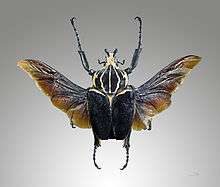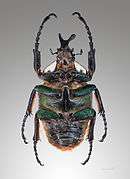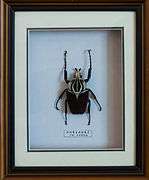Goliathus goliatus
Goliathus goliatus is a species of beetles of the family Scarabaeidae.
| Goliathus goliatus | |
|---|---|
 | |
| Goliathus goliatus, flying position | |
| Dorsal view of Goliathus goliatus at the Montreal Insectarium | |
| Scientific classification | |
| Kingdom: | |
| Phylum: | |
| Class: | |
| Order: | |
| Family: | |
| Subfamily: | |
| Tribe: | Goliathini |
| Subtribe: | Goliathina |
| Genus: | |
| Species: | G. goliatus |
| Binomial name | |
| Goliathus goliatus (Linnaeus, 1771) | |
| Synonyms | |
| |
Description
Goliathus goliatus is one of the largest species in the genus Goliathus, males having a body length of 50–110 millimetres (2.0–4.3 in) and females having a body length of 54–80 millimetres (2.1–3.1 in). The pronotum (thoracic shield) is mainly black, with whitish longitudinal stripes, while elytra are usually dark brown. This pattern may differ greatly in some subspecies and forms.
This species possess a large and membranous secondary pair of wings actually used for flying. When not in use, they are kept completely folded beneath the elytra. The head is whitish, with a black Y-shaped horn in males, used as a pry bar in battles with other males over feeding sites or mates. These beetles feed primarily on tree sap and fruits.
- Goliathus goliatus male, at the Montreal Insectarium
 Goliathus goliatus goliatus male, dorsal side
Goliathus goliatus goliatus male, dorsal side Goliathus goliatus male, ventral side
Goliathus goliatus male, ventral side Goliathus goliatus, male, with spread wings
Goliathus goliatus, male, with spread wings Goliathus goliatus apicalis
Goliathus goliatus apicalis Goliathus goliatus conspersus
Goliathus goliatus conspersus Goliathus goliatus quadrimaculatus
Goliathus goliatus quadrimaculatus
Distribution
This species is widespread from western to eastern equatorial Africa (Nigeria, Cameroon, Central African Republic, Gabon, Republic of the Congo, Democratic Republic of the Congo, Uganda, Western Kenya and Northwestern Tanzania).
Habitat
Goliathus goliatus is mainly present in the equatorial forests and in the sub-equatorial savannah.
Exhibited in 1959 at New York City museum
On January 1, 1959, a species from Gabon, believed to be the first such beetle seen alive in the United States, went on display at the American Museum of Natural History.[1]
References
- Schumach, Murray (January 1, 1959). "Museum to Show World's Biggest Insect; Beetle From Africa Peels Own Bananas". The New York Times. Retrieved November 20, 2019.
| Wikispecies has information related to Goliathus goliatus |
| Wikimedia Commons has media related to Goliathus goliatus. |